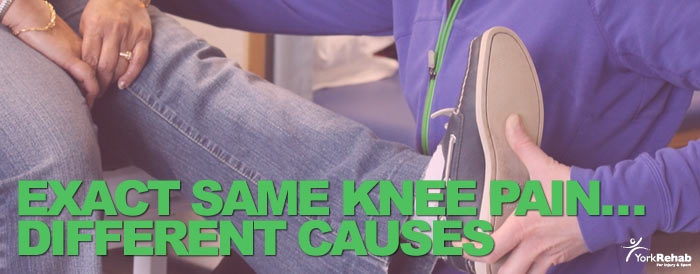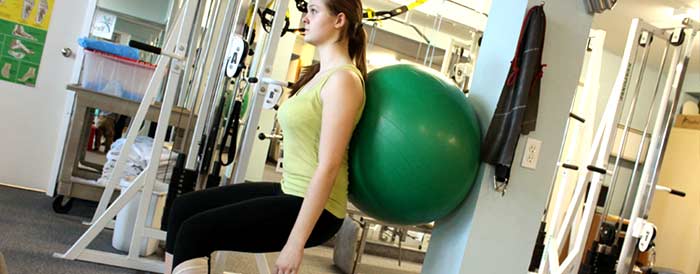Manual Therapy
Exact Same Knee Pain…Different Causes
When you’re told you need to go see a physiotherapist, what do you think of? You may think of stretching, strengthening, heat/ice, ultrasound, endurance training, balance exercises, or electrical stimulation. All these thoughts fall under the category of treatment. What you may not consider is your physiotherapist as a diagnostician. Therapists who are trained in Mechanical Diagnosis & Therapy, also known as the McKenzie Method, are diagnosticians first and foremost. The three cases presented below illustrate this point – all three patients came in with pain in the front of their knees, but the underlying reason for each pain was different and demanded unique management strategies.
The first patient was a 14-year-old female who had right knee pain episodically for the past 2 years – at the time of assessment she had it for 1 month. It was painful when bending, standing, squatting, lunging, and sometimes when sitting, walking, and negotiating stairs, and prevented her from participating in karate. The history and physical exam indicated it could be a typical knee problem, but in the McKenzie Method the lumbar spine (lower back) is first assessed for any contribution – spinal conditions can refer in unusual ways to the extremity. Ultimately it was found that repetitive lumbar extension brought about relief from her knee pain, which she was easily able to do at home, and after some reconditioning exercises, she made a full return to karate.
The second patient was a 60-year-old male who had pain in both knees for a year after a day of heavy ladder use at work. The pain was there mostly when getting out of a chair and walking the first few steps, and also sometimes with squatting. As with the patient above, his lower back was assessed for any contribution and was ruled out because of no change to his presentation. His knees were then assessed with repetitive movement testing. Repetitive straightening (hyperextension) caused a significant reduction in his squatting pain. Within a week of performing this exercise 4-5 times per day, he was 90% free of pain with full movement and strength.
The third patient was a 39-year-old male who had right knee pain intermittently for 2 years after doing some moving; going up and down stairs and squatting were his two most painful activities. As above, his lumbar spine was assessed first, which had no effect on his presentation, so it was ruled out. Repeated knee movements also had no lasting effect but it was found that repetitive straightening of his knee with an ankle weight consistently produced his pain. This pain did not remain afterward. This presentation is consistent with a dysfunction or suboptimal healing of the patellar tendon. Consistent remodeling of his tendon via progressive resistance exercises over two months proved to steadily diminish his pain. He was able to go up and down stairs without pain at that point and had made a return to biking.
The three cases outlined above all had frontal knee pain, but for different reasons: one was due to a lower back joint problem, one was due to a knee joint problem, and the last was the result of a patellar tendon dysfunction. These diagnoses were sorted out following the principles of the McKenzie Method and each patient was given an effective self-management strategy that led to resolution of the problem. Make sure the next time you need to see a physiotherapist that you are given a good mechanical assessment that focuses on understanding the cause of your problem, and not just what can be done to treat the symptoms.
Our Newmarket Physiotherapy clinic has several physiotherapists trained as McKenzie Method practitioners. Our physio clinic also has 2 of only a handful of therapists in Canada who have completed the Diploma Program in Mechanical Diagnosis and Therapy (MDT) and the most number of credentialed therapists in an Ontario clinic.
The McKenzie Method – Mechanical Diagnosis & Therapy (MDT)
If you’ve ever had joint pain, this situation may be familiar to you: every family member, friend, and coworker has the time-honoured “magic solution” to get you better. Whether it’s heat, medication, meditation, or dousing yourself in honey, everyone has a suggestion. One you may have heard about is doing “McKenzie exercises” to recover. What are these exercises? Are they effective? How does it work?
“Mechanical Diagnosis & Therapy” or MDT
Also known as Mechanical Diagnosis & Therapy (MDT), the McKenzie Method is a comprehensive assessment system for orthopedic conditions such as back pain or shoulder pain, and is more than just a series of exercises. It allows the assessor to reliably classify you into different subgroups so that the right treatment can be applied. Practitioners need to understand you and your condition before they can hope to begin any treatment. It’s just like taking your car into the mechanic when something is malfunctioning – a good mechanic will take the time to ask you what the problem is (what are the symptoms?), and then will run tests to determine the source of the problem (does it hurt if you move that way?). You can’t expect the repairs to be made immediately – careful diagnosis is required first.
The McKenzie Method system was developed by New Zealand physiotherapist Robin McKenzie in the 1950s and 60s. One day he had a patient with back pain radiating down to his foot come in and he told him to go lie down on an unoccupied bed. Little did Robin know, the top half of the bed was at an angle, so the patient laid face-down on the bed with his back in maximum extension (like the cobra position in yoga). At the time the conventional wisdom was this was a terrible position for back pain. However, when Robin asked the patient how he was doing, he remarked that the leg pain had disappeared. This was so contrary to all his teachings that it inspired him to begin experimenting with different postures and movements and making careful observations with his patients. Patterns began to emerge, and he realized that these patterns could apply to all joints of the body.
McKenzie Method Today
Today the McKenzie Method is practiced globally by rehabilitation professionals of many backgrounds. Since its humble beginnings in New Zealand, it has been supported by numerous scientific publications around the world. Despite this, it is not a universally adopted system. Because the emphasis is first on understanding the problem at its root, which may take several sessions to achieve, it is at odds with the “treatment first” approach. Too often in rehabilitation the approach is to treat the symptoms with modalities such as heat or electrical stimulation, as opposed to getting an understanding of the cause. Fortunately, when the cause is identified using MDT, treatment can be very effective.
The majority of musculoskeletal problems are mechanical in nature – they are affected by movement. Mechanical problems require mechanical solutions, and often it is simply a matter of finding the right direction and force to move into. For example, a person with knee pain might respond to repeated knee straightening movements and have less pain and improved squatting mechanics as a result. If the right movement is applied regularly and aggravating factors are avoided, then rapid improvement is seen, often in a matter of days. Most people can treat themselves once they know what to do – patient independence is one of the central philosophies of MDT. This saves time and eliminates the need for long courses of treatment with many visits. Additionally, you will be shown how to prevent future episodes from occurring, and how to self-treat if the pain does happen to return.
So, the next time that shoulder starts to ache or your knee starts to lock up, instead of using the old family remedies, try looking up a certified McKenzie practitioner. The solution to your problem may be simpler than you think. York Rehab’s Newmarket Physiotherapy clinic has the most therapists certified in McKenzie treatment in Ontario.
YRA hosts 2 day McKenzie MDT course
The McKenzie Method of Mechanical Diagnosis and Treatment (MDT) is a safe, structured and evidence-based system used to assess and treat patients. The system can be applied to the spine and/or extremities. As MDT therapists, our greatest skill lies in our assessment, where we use the information collected from the symptomatic and mechanical presentation of a patient to classify them into a particular group. From there, we can then match our treatment approach with the particular classification. Patients receive a program designed specifically for them, emphasizing education, active involvement, self-management and prevention of recurrence. With continual assessment and re-assessment (often <6 sessions) of the patient, results are achieved fast, decreasing the financial burden to patients.
Physiotherapy can make you stronger
“Physiotherapy can make you stronger in so many ways.” This phrase is front and centre on the Ontario Physiotherapy Association’s facebook site. With so many tools in our toolbox, our role at York Rehab is to help improve your pain and function, as well as improve the quality of your life! The team at York Rehab is committed to help you recover from injury, learn how to prevent injury, and improve all aspects of your fitness and health.
As described by the Canadian Physiotherapy Association, physiotherapy is rooted in movement sciences, using both a holistic and individualized approach. With extensive experience in post-graduate course work, the York Rehab team offers an assessment and treatment approach that is evidence based – meaning our therapy ensures the most optimal care and outcomes. Just as our degree program in Physical Therapy was completed within a Faculty of Medicine, our continuing education allows us to assume an important role within your health care team.
At York Rehab, we provide a treatment approach that uses specifically designed exercises unique to each patient, manual therapy, and various physiotherapy modalities (such as ultrasound, acupuncture, biofeedback). As the Canadian Academy of Manipulative Therapists explains: Manual therapists are well trained to use their hands to diagnose and treat limitations in movement in the spine, arms and legs. Using gentle, hands-on techniques, we can help reduce muscle tightness, improve movement in the joints, reduce pain and improve function.
Did you know that we are also trained in joint manipulation? A joint manipulation is a passive high velocity (quick) low amplitude (small) thrust that is applied to a joint beyond its physiological limit of motion, but within its anatomical limit – intended to restore optimal motion, function and/or reduce pain. Well within our scope (or skill) of practice, and regulated by The College of Physiotherapists of Ontario, physiotherapists use manipulations selectively – when the assessment, clinical experience, evidence, and patient consent indicate it is the best treatment approach. Our manipulation techniques are extensions of our mobilizations, and isolated and localized to a specific direction. In fact, we often use a distractive technique that can offer immediate relief without torque, twist or strain.
Both Bob Lyeo and Jen Bladon are Fellows with the Canadian Academy of Manipulative Therapists in Canada, whereas Ann Botham, Fiona MacKenzie, and Liisa Ruomo-Reddy are credentialed MacKenzie therapists. Having completed rigorous training, mentorship hours, and qualifying examinations, their practice also includes safe and effective spinal manipulations. When identified as an effective and necessary tool – after thorough assessment and in addition to therapeutic exercise and education – manual therapy and safe manipulation practices are an integral part of the York Rehab approach –towards recovery and a stronger you. :)
As analytical and movement experts, you are in good hands at York Rehab!!








